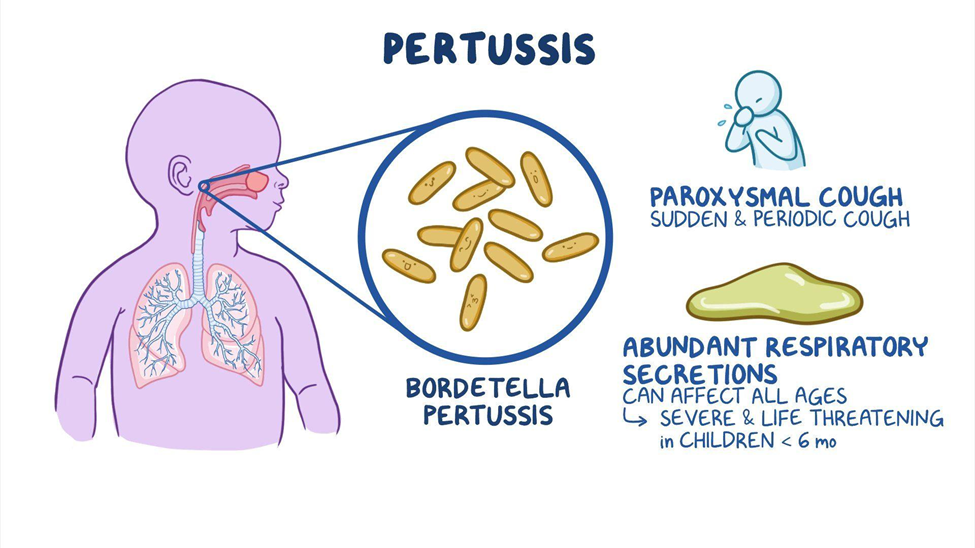The nurse performs an assessment of a child with pertussis (whooping cough). Which finding would the nurse identify as indicative of a potential complication?
A urinary output of 30 mL/hr
A white blood cell (WBC) count of 10.000 mm3 (10×109/L)
Decreased breath sounds in the lung bases
A weight gain
The Correct Answer is C
A. A urinary output of 30 mL/hr
Explanation: While decreased urinary output may indicate dehydration, it is not a specific finding related to pertussis. Dehydration can occur due to inadequate fluid intake or loss through vomiting or sweating.
B. A white blood cell (WBC) count of 10,000 mm3 (10×10^9/L)
Explanation: An elevated white blood cell count is a common finding in infections, including pertussis. It reflects the body's immune response to the infection. A WBC count of 10,000 mm3 is within the normal range, and while it indicates an inflammatory response, it does not specifically point to a complication.
C. Decreased breath sounds in the lung bases
Explanation:
Pertussis is a respiratory infection caused by the bacterium Bordetella pertussis. Complications can arise, including pneumonia. Decreased breath sounds in the lung bases may suggest the presence of pneumonia, which is a serious complication of pertussis. Pneumonia can lead to respiratory distress and requires prompt medical attention.
D. A weight gain
Explanation: Weight gain is not typically associated with pertussis. In fact, respiratory distress and difficulty feeding during coughing paroxysms can lead to weight loss in infants with pertussis. Weight gain may be indicative of other unrelated factors.

Nursing Test Bank
Naxlex Comprehensive Predictor Exams
Related Questions
Correct Answer is D
Explanation
A. 1 cup cooked rice: This exceeds the 1 oz serving size and is more than what the nurse is recommending.
B. Flour tortilla: The size of a flour tortilla can vary, but it often exceeds the 1 oz serving size, so it may provide more than the recommended amount.
C. 1 cup ready-to-eat cereal flakes: The volume of cereal can vary, and 1 cup of cereal may provide more than 1 oz of grains, depending on the type and density of the cereal.
D. 1 slice whole wheat bread: A standard slice of whole wheat bread typically provides around 1 oz of grains, making it an appropriate choice for the recommended serving size.
Correct Answer is C
Explanation
A. Meningococcal polysaccharide vaccine
Explanation: Meningococcal vaccine is recommended for adolescents, particularly before starting college, as it helps protect against meningococcal disease. The conjugate form of the vaccine is usually preferred over the polysaccharide form.
B. Pneumococcal polysaccharide vaccine
Explanation: Pneumococcal vaccine is generally recommended for older adults and individuals with specific medical conditions, but it may not be part of routine immunizations for healthy adolescents.
C. Influenza vaccine
Explanation:
Influenza vaccine is recommended annually for adolescents as part of routine immunizations. It helps protect against the seasonal flu, which can cause significant illness and complications.
D. Bacille Calmette-Guerin (BCG) vaccine
Explanation: BCG vaccine is primarily used in some countries to prevent tuberculosis. It is not routinely administered in the United States as part of standard immunization schedules for adolescents.
Whether you are a student looking to ace your exams or a practicing nurse seeking to enhance your expertise , our nursing education contents will empower you with the confidence and competence to make a difference in the lives of patients and become a respected leader in the healthcare field.
Visit Naxlex, invest in your future and unlock endless possibilities with our unparalleled nursing education contents today
Report Wrong Answer on the Current Question
Do you disagree with the answer? If yes, what is your expected answer? Explain.
Kindly be descriptive with the issue you are facing.
